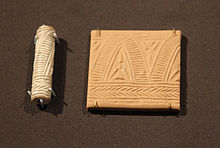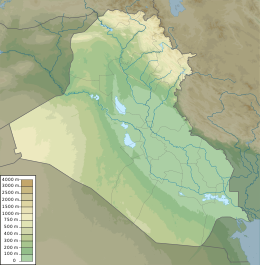Jemdet Nasr period
 Area corresponding to the Jemdet Nasr culture in light brown. The area corresponding to the Uruk culture is in yellow. | |
| Geographical range | Mesopotamia |
|---|---|
| Period | Bronze Age |
| Dates | c. 3100 BC – c. 2900 BC |
| Type site | Tell Jemdet Nasr |
| Major sites | Tell Abu Salabikh, Tell Fara, Tell Khafajah, Nippur, Tell Uqair, Tell el-Muqayyar, and Eanna district, Bit Resh (Kullaba), and Irigal |
| Preceded by | Uruk Period |
| Followed by | Early Dynastic Period |
The Jemdet Nasr Period is an archaeological culture in southern Mesopotamia (modern-day Iraq). It is generally dated from 3100 to 2900 BC. It is named after the type site Tell Jemdet Nasr, where the assemblage typical for this period was first recognized. Its geographical distribution is limited to south-central Iraq. The culture of the proto-historical Jemdet Nasr period is a local development out of the preceding Uruk period and continues into the Early Dynastic I period.
History of research
In the early 1900s,
The importance of these finds was realized immediately and the Jemdet Nasr Period (named after the eponymous type site) was officially defined at a conference in Baghdad in 1930, where at the same time both the Uruk and Ubaid periods had been defined.
Dating and periodization
Older scientific literature often used 3200–3000 BC as the beginning and end dates of the Jemdet Nasr Period. The period is nowadays dated from 3100 to 2900 BC based on
Defining characteristics


The hallmark of the Jemdet Nasr Period is its distinctive painted monochrome and polychrome pottery. Designs are both geometric and figurative; the latter displaying trees and animals such as birds, fish, goats, scorpions, and snakes. Nevertheless, this painted pottery makes up only a small percentage of the total assemblage and at various sites it has been found in archaeological contexts suggesting that it was associated with high-status individuals or activities. At the site of Jemdet Nasr, the painted pottery was found exclusively in the settlement's large central building, which is thought to have played a role in the administration of many economic activities. Painted Jemdet Nasr Period pots were found in similar contexts at Tell Fara and Tell Gubba, both in the Hamrin Mountains.[8]
Apart from the distinctive pottery, the period is known as one of the formative stages in the development of the
While the language in which these tablets were written cannot be identified with certainty, it is thought to have been
Society in the Jemdet Nasr Period
The centralized buildings, administrative cuneiform tablets and cylinder seals from sites like Jemdet Nasr suggest that settlements of this period were very organized, with a central administration regulating all aspects of the economy, from crafts to agriculture to the rationing of foodstuffs.
The economy seems to have been primarily concerned with subsistence based on agriculture and sheep-and-goat pastoralism and small-scale trade. Very few precious stones or exotic trade goods have been found at sites of this period. However, the homogeneity of the pottery across the southern Mesopotamian plain suggests intensive contacts and trade between settlements. This is strengthened by the find of a sealing at Jemdet Nasr that lists a number of cities that can be identified, including Ur, Uruk, and Larsa.[13]
Artifacts
-
Painted ceramic vessel from the Jemdet Nasr period, found atOriental Institute, Chicago.
-
Cup with nude heroes. Jemdet Nasr to Pre-Dynastic period, 3000-2600 BC.
-
Reverse of the same cup with Nude Hero, Bulls and Lions, Tell Agrab, Jamdat Nasr to Early Dynastic period, 3000-2600 BC.
-
Jemdet Nasr Period bull statue from limestone (found in Uruk, Iraq.)
-
Djemdet Nasr stone bowl, once inlaid with mother-of-pearl, red paste, and bitumen.
-
Cylinder seals, Djemdet Nasr 3.
-
Late uruk/ Jeldet Nasr period cylinder seal (3350-2900 BC).
-
Late uruk/ Jeldet Nasr period cylinder seal (3350-2900 BC).
-
Late uruk/ Jeldet Nasr period cylinder seal (3350-2900 BC).
-
Late uruk/ Jeldet Nasr period cylinder seal (3350-2900 BC).
-
Egypt-Mesopotamia relations.[14]
-
Administrative tablet, Jamdat Nasr period 3100–2900 BC, probably from the city of Uruk.
-
A Pottery jar from Jemdet Nasr period (3100-2900)B.C
See also
References
- ^ Matthews 2002, pp. 1–7
- ^ Matthews 2002, p. 20
- ^ Pollock 1992, p. 299
- ^ Pollock 1999, p. 2
- ^ Postgate 1992, p. 22
- ^ van de Mieroop 2007, p. 19
- ^ Matthews 2002, p. 37
- ^ Matthews 2002, pp. 20–21
- ^ Woods 2010, pp. 36–37
- ^ Woods 2010, pp. 44–45
- ^ Woods 2010, p. 39
- ^ Woods 2010, p. 35
- ^ Matthews 2002, pp. 33–37
- S2CID 161166931.
Bibliography
- ISBN 0-85668-735-9
- S2CID 161700843
- Pollock, Susan (1999), Ancient Mesopotamia. The Eden that never was, Case Studies in Early Societies, Cambridge: Cambridge University Press, ISBN 978-0-521-57568-3
- ISBN 978-0-415-11032-7
- ISBN 978-0-631-22552-2
- Woods, Christopher (2010), "The earliest Mesopotamian writing" (PDF), in Woods, Christopher (ed.), Visible language. Inventions of writing in the ancient Middle East and beyond, Oriental Institute Museum Publications, vol. 32, Chicago: University of Chicago, pp. 33–50, ISBN 978-1-885923-76-9
Further reading
- Potts, D.T. (1986). "A contribution to the history of the term 'Ǧamdat Naṣr'". In Finkbeiner, Uwe; Röllig, Wolfgang (eds.). Ǧamdat Naṣr: period or regional style? : papers given at a symposium held in Tübingen, November 1983. Wiesbaden: Reichert. pp. 17–32. OCLC 16224643.<










![Jemdet Nasr-style Mesopotamian cylinder seal, from Grave 7304 Cemetery 7000 at Naqada, Egypt, Naqada II period. This is an example of early Egypt-Mesopotamia relations.[14]](http://upload.wikimedia.org/wikipedia/commons/thumb/2/24/Jemdet_Nasr_style_Mesopotamian_cylinder_seal_from_Grave_7304_Cemetery_7000_at_Naqada.jpg/120px-Jemdet_Nasr_style_Mesopotamian_cylinder_seal_from_Grave_7304_Cemetery_7000_at_Naqada.jpg)


